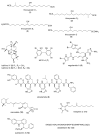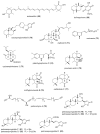Marine pharmacology in 2003-4: marine compounds with anthelmintic antibacterial, anticoagulant, antifungal, anti-inflammatory, antimalarial, antiplatelet, antiprotozoal, antituberculosis, and antiviral activities; affecting the cardiovascular, immune and nervous systems, and other miscellaneous mechanisms of action
- PMID: 17392033
- PMCID: PMC2151674
- DOI: 10.1016/j.cbpc.2007.01.015
Marine pharmacology in 2003-4: marine compounds with anthelmintic antibacterial, anticoagulant, antifungal, anti-inflammatory, antimalarial, antiplatelet, antiprotozoal, antituberculosis, and antiviral activities; affecting the cardiovascular, immune and nervous systems, and other miscellaneous mechanisms of action
Abstract
The current marine pharmacology review that covers the peer-reviewed literature during 2003 and 2004 is a sequel to the authors' 1998-2002 reviews, and highlights the preclinical pharmacology of 166 marine chemicals derived from a diverse group of marine animals, algae, fungi and bacteria. Anthelmintic, antibacterial, anticoagulant, antifungal, antimalarial, antiplatelet, antiprotozoal, antituberculosis or antiviral activities were reported for 67 marine chemicals. Additionally 45 marine compounds were shown to have significant effects on the cardiovascular, immune and nervous system as well as possessing anti-inflammatory effects. Finally, 54 marine compounds were reported to act on a variety of molecular targets and thus may potentially contribute to several pharmacological classes. Thus, during 2003-2004, research on the pharmacology of marine natural products which involved investigators from Argentina, Australia, Brazil, Belgium, Canada, China, France, Germany, India, Indonesia, Israel, Italy, Japan, Mexico, Morocco, the Netherlands, New Zealand, Norway, Panama, the Philippines, Portugal, Russia, Slovenia, South Korea, Spain, Thailand, Turkey, United Kingdom, and the United States, contributed numerous chemical leads for the continued global search for novel therapeutic agents with broad spectrum activity.
Figures
References
-
- Agafonova IG, Aminin DL, Avilov SA, Stonik VA. Influence of cucumariosides upon intracellular [Ca2+]i and lysosomal activity of macrophages. J Agric Food Chem. 2003;51:6982–6986. - PubMed
-
- Aiello A, Borrelli F, Capasso R, Fattorusso E, Luciano P, Menna M. Conicamin, a novel histamine antagonist from the mediterranean tunicate Aplidium conicum. Bioorg Med Chem Lett. 2003;13:4481–4483. - PubMed
-
- Alonso D, Khalil Z, Satkunanthan N, Livett BG. Drugs from the sea: conotoxins as drug leads for neuropathic pain and other neurological conditions. Mini Rev Med Chem. 2003;3:785–787. - PubMed
-
- Aneiros A, Garateix A. Bioactive peptides from marine sources: pharmacological properties and isolation procedures. J Chromatogr B Analyt Technol Biomed Life Sci. 2004;803:41–53. - PubMed
-
- Ankisetty S, Amsler CD, McClintock JB, Baker BJ. Further membranolide diterpenes from the antarctic sponge Dendrilla membranosa. J Nat Prod. 2004;67:1172–1174. - PubMed
Publication types
MeSH terms
Substances
Grants and funding
LinkOut - more resources
Full Text Sources
Other Literature Sources




